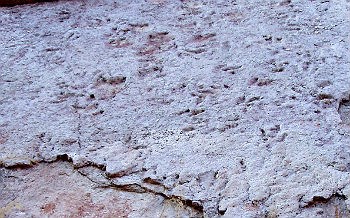
Graphic adapted from Lockley & Hunt (1995) by Geoscientist-In-the Park David Tarailo, sponsored by the Geological Society of America, GeoCorps Program, fall 2012. 
Graphics by Geoscientist-In-the Park David Tarailo, sponsored by the Geological Society of America, GeoCorps Program, fall 2012. What you may not realize is that when your foot presses down the sand surface, the pressure also affects the layers of sand underneath. Your foot squishes those layers down, but preserves less detail than the true track on the surface. These squished layers under the true track are called "under tracks."
If the tracks remain exposed for a short while, the sediment may dry out and harden. The imprint may then act as a natural mold, and if it is rapidly filled in by other sediment, a natural cast may be created. These positive-relief casts are often found on the underside of overhanging rocks, much like under tracks, though usually with more detail.
In Zion, examples of true dinosaur tracks, under tracks, and natural casts have been found in the Moenave and Kayenta Formations.
Learn more about the dinosaur tracks in Zion

NPS photo / Bradley Markle Learn how other fossils are made
Return to the main Paleontology page
|
Last updated: June 13, 2015
